The article Geophysics is a continuation of a series of articles on physics for the engineering and security fields, such as:
Geophysics is a frontier science at the interface between geology and physics, it is based on the study of various geophysical fields existing in the inhomogeneous earth body and its surroundings (i.e. gravity field, magnetic field, etc.). In practice, we mainly encounter the so-called used or practical geophysics, i.e. an applied scientific discipline that deals with specific tasks of geological practice (repository and engineering geophysics, hydrogeology). Applied geophysics uses available knowledge from the field of physics, geology and modern mass processing methods:
- – by analyzing the physical fields of the earth’s body, in order to solve the problem of its shape and structure (the internal structure of the Earth – especially the structure of the earth’s crust and upper mantle, etc.),
- – solving problems in the field of general, structural and deposit geology (tectonophysics; searching for mineral deposits; locating faults, etc.),
- – solving problems in the field of engineering geology, environmental geology, hydrogeology, etc.
- The mentioned methods measure and analyze the character of the field:
- gravimetry – gravity field,
- – geomagnetics – geomagnetic field,
- – geoelectrics – geoelectric field,
- – seismic survey – wave field,
- – seismology – wave field,
- – radionuclide methods – radioactive field,
- – geothermal – heat field,
- – geophysical changes in wells, so-called logging methods – electrical, acoustic, nuclear and measurement of physical properties of liquids.
The following paragraphs briefly describe the individual methods, their essence and method of use, especially in security fields. They contain research, direct quotations or paraphrases of the following sources: 1ŠVANCARA, Jan, HAVÍŘ, Josef, VEJMĚLEK, lIBOR. Základy geofyziky. Studijní materiály předmětu PřF:G1101 Základy geofyziky. Brno: Informační systém Masarykovy univerzity 2009. Dostupné z: https://is.muni.cz/el/1431/podzim2011/G1101/9009799, 2POSPÍŠIL, Lubomil. Geofyzika a geodynamika. Modul #1, Studijní opory pro studijní programy s kombinovanou formou studia. Brno: VUT v Brně Fakulta stavební 2007. 3ŠVANCARA, Jan. Seismika. Studijní materiály předmětu PřF:G1101 Základy geofyziky. Brno: Informační systém Masarykovy univerzity 2009. Dostupné z: https://is.muni.cz/el/1431/podzim2011/G1101/9009799,4 HAVÍŘ, Josef. Seismologie. Studijní materiály předmětu PřF:G1101 Základy geofyziky. Brno: Informační systém Masarykovy univerzity 2009. Dostupné z: https://is.muni.cz/el/1431/podzim2011/G1101/9009799, 5PROCHÁZKOVÁ, Dana. Seismické inženýrství na prahu třetího tisíciletí. [Praha: s.n, 2002. ISBN 80-238-8661-4.
Gravimetry
Gravimetry studies the earth’s gravity field, compiles gravity maps that show density abnormalities in the earth’s crust (Švancara). The images below show the principle of the gravimeter and the resulting gravimetric map of the Czech Republic. Physical geodesy uses the obtained values of gravitational acceleration primarily for the purposes of determining and specifying the shape of the Earth, e.g. using an ellipsoid, spheroid, geoid (Pospíšil), see the image Description of the geoid (Švancara).
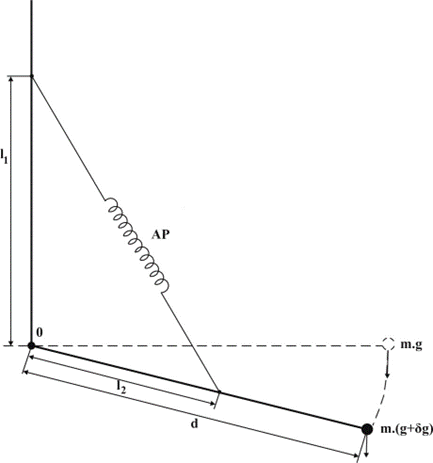
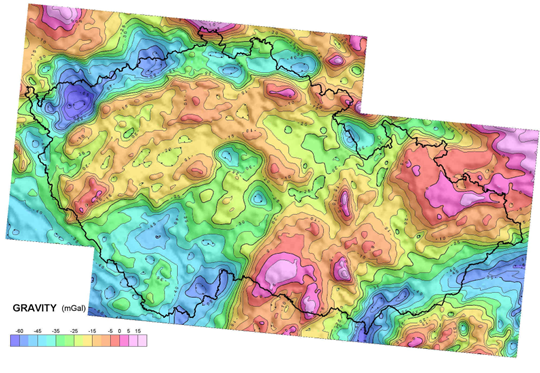
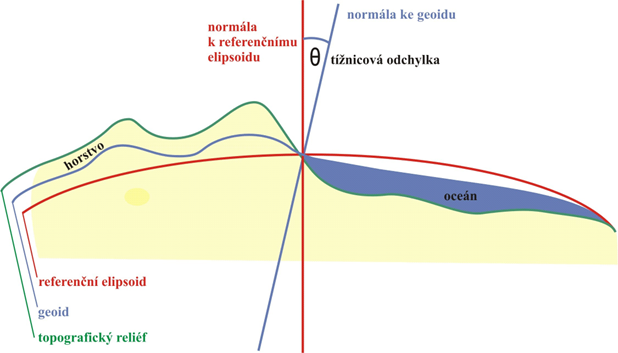
The results of gravimetric measurements are loaded with factors causing changes in the readings on the gravimeter, i.e. which cause different values to be measured at different moments of time. For example, the so-called tidal effect, i.e. changes in the gravimeter reading caused by the gravitational effect of the Sun and the Moon. Other factors that must be considered when measuring are the following effects (or effect) 6POSPÍŠIL, Lubomil. Geofyzika a geodynamika. Modul #1, Studijní opory pro studijní programy s kombinovanou formou studia. Brno: VUT v Brně Fakulta stavební 2007.:
- – of an ideal terrestrial body – a spheroid, or ellipsoid”, i.e. material objects that are closest to the shape of the Earth,
- – caused by the Earth’s rotation (the magnitude of which is directly dependent on the latitude of the analyzed gravity point),
- – related to the change in the value of the gravitational acceleration, depending on the altitude,
- – vertical components of mass attraction of topographical irregularities, located in the vicinity of each measuring station, to each point of the earth’s surface.”
To eliminate measurement deviations due to the mentioned effects, the following methods are used: correction by the value of the so-called normal field ( gn ); Fay reduction; Bouguer reduction; reduction to topographic relief irregularities – or topographic correction; isostatic reduction.
Geomagnetics
Geomagnetics or magnetometry studies the Earth’s magnetic field, it allows searching for minerals containing magnetic minerals. The output of geomagnetic measurements are (similarly to gravimetry) geomagnetic maps. The figure below describes the principle of a proton magnetometer7 ŠVANCARA, Jan, HAVÍŘ, Josef, VEJMĚLEK, lIBOR. Základy geofyziky. Studijní materiály předmětu PřF:G1101 Základy geofyziky. Brno: Informační systém Masarykovy univerzity 2009. Dostupné z: https://is.muni.cz/el/1431/podzim2011/G1101/9009799. The picture below shows a proton magnetometer and the next picture shows a capacitance meter to measure the magnetic susceptibility χm (χm = M/H; where M is the magnetization and H is the magnetic field strength).
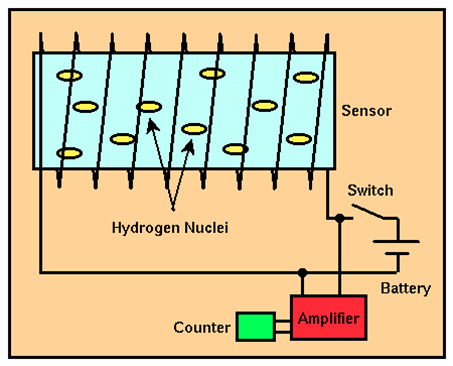
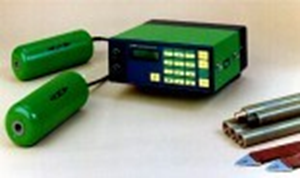
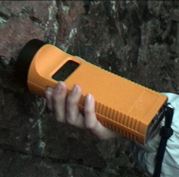
Geoelectrics
Geoelectrics deals with both the measurement and analysis of the Earth’s stationary natural electric field, as well as a wide range of artificially induced stationary electric and non-stationary electromagnetic fields 8POSPÍŠIL, Lubomil. Geofyzika a geodynamika. Modul #1, Studijní opory pro studijní programy s kombinovanou formou studia. Brno: VUT v Brně Fakulta stavební 2007.
In practice, geoelectric methods are divided into direct current methods, electrochemical and electromagnetic methods. I.e. searching for differences in rocks in their resistivity, permittivity, or electrochemical activities.
The resistivity of rocks is influenced by many factors, mainly: the mineralogical composition of the rock, porosity, the degree of water saturation of the rock, the mineralization of the fluid that fills the pores, the structure and texture of the rock, as well as pressure and temperature. In applied geophysics, the resistivity of rocks is determined as the resistance that a cube offers to an electric current by a 1m edge in a direction perpendicular to the cube wall 9POSPÍŠIL, Lubomil. Geofyzika a geodynamika. Modul #1, Studijní opory pro studijní programy s kombinovanou formou studia. Brno: VUT v Brně Fakulta stavební 2007.
Permittivity generally expresses the ability to strengthen or weaken the electric field due to polarization – i.e. according to the ordered orientation of the bound electric charges. In geoelectrical practice, it was introduced as a dimensionless quantity. For different rocks, it varies from 2 to 3, up to values around 40. Minimum values tend to be typical for dry porous rocks. Maximum values are usually indicated for these rocks in cases where they are fully saturated with water. The decisive factor that determines the size of the permittivity is therefore primarily the degree of water saturation of the rock 10POSPÍŠIL, Lubomil. Geofyzika a geodynamika. Modul #1, Studijní opory pro studijní programy s kombinovanou formou studia. Brno: VUT v Brně Fakulta stavební 2007.
Geoelectrical methods are widely used in geology, hydrogeology, geotechnics, construction, in the investigation of slope deformations, in the search for contamination of the rock environment and in the implementation of subsequent remediation methods, as well as in archaeological practice, respectively. and in many other industries 11POSPÍŠIL, Lubomil. Geofyzika a geodynamika. Modul #1, Studijní opory pro studijní programy s kombinovanou formou studia. Brno: VUT v Brně Fakulta stavební 2007.
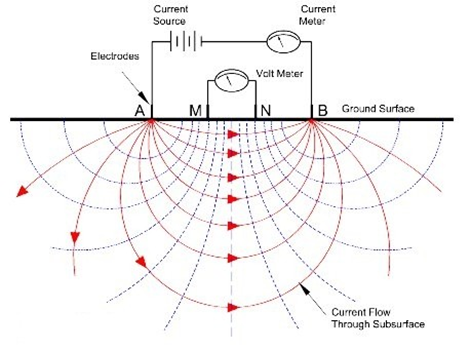
Seismic survey
Seismic exploration (hereafter referred to as seismic) deals with a set of methods that, based on the study of artificially induced elastic (seismic) waves, analyze the Earth’s crust and, exceptionally, the Earth’s upper mantle. After passing through the upper parts of the earth’s body, these waves return to the surface and carry information about the environment through which they passed. It is the main prospecting method for oil and gas 12ŠVANCARA, Jan, HAVÍŘ, Josef, VEJMĚLEK, lIBOR. Základy geofyziky. Studijní materiály předmětu PřF:G1101 Základy geofyziky. Brno: Informační systém Masarykovy univerzity 2009. Dostupné z: https://is.muni.cz/el/1431/podzim2011/G1101/9009799, 13ŠVANCARA, Jan. Seismika. Studijní materiály předmětu PřF:G1101 Základy geofyziky. Brno: Informační systém Masarykovy univerzity 2009. Dostupné z: https://is.muni.cz/el/1431/podzim2011/G1101/9009799.
Seismics deals with and solves the following areas.
Types of seismic waves: longitudinal “P” and transverse “S” (for special applications).
Sources of seismic energy:
- – detonation of explosives (usually in a borehole),
- – vibrators,
- – hammer, weights, projectile (shallow seismic),
- – grouping of buying wave sources (simultaneous, successive summation).
Propagation of seismic waves: seismic waves propagate from their source in all directions at a speed that depends on the physical properties of the analyzed medium (homogeneous, layered) and on the type of seismic wave.
Reflection and refraction. The cause of reflection and refraction of seismic waves at layer interfaces is primarily the difference in velocities and densities in these layers. E.g. if we assume the existence of two homogeneous environments that are separated by a plane interface and the propagation speeds of seismic waves in them are v1 and v2, after the impact of the longitudinal seismic wave P on this interface (and at its expense) secondary waves will arise. In the upper environment, these are primarily reflected waves, and in the lower environment, passing through – refracted (refracted) waves14 POSPÍŠIL, Lubomil. Geofyzika a geodynamika. Modul #1, Studijní opory pro studijní programy s kombinovanou formou studia. Brno: VUT v Brně Fakulta stavební 2007..
Interference. Other waves may also reach the surface that cancel the registration of useful waves (or useful signal), i.e. interfering waves that must be filtered during evaluation. This is, for example, 15POSPÍŠIL, Lubomil. Geofyzika a geodynamika. Modul #1, Studijní opory pro studijní programy s kombinovanou formou studia. Brno: VUT v Brně Fakulta stavební 2007.:
- – a direct longitudinal wave (which spreads along the earth’s surface and when it is usually a frontal wave which spreads along the surface of the rock base, in the subsoil of the so-called weathered layer),
- – transverse (reflected and frontal) waves,
- – transformed waves,
- – multiple waves (which arise especially after the impact of longitudinal reflected waves on the earth’s surface and are reflected back to the depth, where they are reflected again and return to the surface,
- – waves that in some cases also arise after the impact of longitudinal reflected waves on some interfaces inside the analyzed environment, when they also return to the depth and only then reach the surface)
- – diffracted waves that arise especially when seismic waves impact some discontinuities of the monitored interfaces or other inhomogeneities of the analyzed environment,
- – microseisms, which are usually caused, for example, by the effect of rain on the earth’s surface, or by the movement and activity of various means of transport, etc.
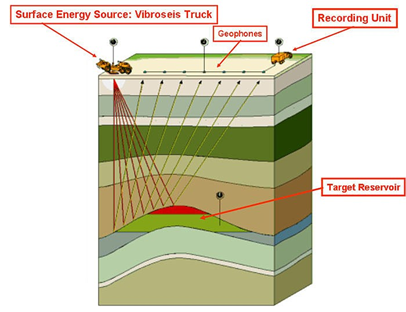
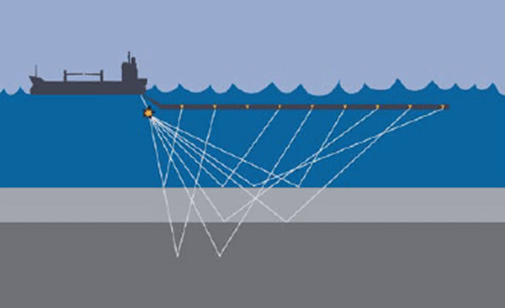
Registration and processing of seismic records. Registration of the arrival of seismic waves (seismic channel) is carried out in pre-selected places, by means of a geophone, i.e. a sensor based on the principle of electromagnetic induction, a so-called seismic trace (route) is recorded. Disturbing surface influences are suppressed by grouping geophones. The results are further processed mainly in the computer, the processing is time sections, migrations, depth sections. Special processing methods in hydrocarbon prospecting are, for example: amplitude analysis, determination of reflection coefficients, AVO (Amplitude Versus Offset) method.
Seismology
According to (Havíř), seismology focuses on the problem of generation, propagation and recording of elastic waves in the Earth and other natural cosmic bodies (i.e. seismic phenomena or events). Seismology primarily monitors natural seismic waves generated during earthquakes, which usually pass through the entire earth’s body. Seismology also studies the natural seismic waves that occur during earthquakes. These waves carry information about the elastic properties of the entire Earth. It also includes, for example, special methods for monitoring nuclear explosions (different from earthquakes and large explosions in quarries). From the point of view of safety fields, seismology is one of the most important areas of geophysics, as seismic events tend to be the trigger (or cause) of a number of technological accidents and various cascading effects, causing losses to public assets (people’s lives and health, their property, i.e. losses in the human system , losses in the technological system or losses in the environment, etc.).
The main subject of seismology is earthquakes – the process by which short-period elastic waves are generated. The study of the sources of natural earthquakes and the propagation of the seismic signal through the earth’s body brings fundamental knowledge about the structure of the Earth and refines knowledge about the nature of tectonic processes (Havir).
Seismic events that we currently register are divided into natural earthquakes, earthquakes induced by human activity, artificial explosions and vibrations of natural or artificial origin (they arise as a result of technological processes and natural phenomena; falls of meteorites, airplanes, bombs, etc.) 16PROCHÁZKOVÁ, Dana. Seismické inženýrství na prahu třetího tisíciletí. [Praha: s.n, 2002. ISBN 80-238-8661-4.. An earthquake is a physical phenomenon that is manifested by short-term rapid movements of the earth’s surface. These movements last from a few seconds to several tens of seconds. They are caused by seismic waves that spread from the focus of the earthquake through the earth’s body. In the case of very strong earthquakes, seismic waves propagate through the Earth’s body for several hours (we are talking about the so-called natural oscillations of the Earth). The cause of 90% of (natural) earthquakes is the release of accumulated tectonic stresses in the earth’s crust and in the upper mantle up to a depth of about 750 km, which arises as a result of ongoing endogenous processes in the earth’s body. These earthquakes (so-called tectonic) occur in three zones that are at the interface of the plates forming the Earth’s lithosphere. About 7% of earthquakes are associated with volcanic activity and 3% with the collapse of rock massifs (so-called thrusting earthquakes) 17PROCHÁZKOVÁ, Dana. Seismické inženýrství na prahu třetího tisíciletí. [Praha: s.n, 2002. ISBN 80-238-8661-4..
An earthquake is a product of processes in the earth’s crust and upper mantle that take place in the current geological epoch in certain areas and are a continuation of past events. It is created by the sudden release of mechanical energy. As a breaking process, it begins to develop at a point we call the hypocenter. The vertical projection of the hypocenter on the Earth’s surface is called the epicenter. The focal point or focus area (focal area) is an area in which irreversible deformations occur during an earthquake. Outside the focal point, the earthquake mainly manifests itself only as seismic waves (i.e. vibrations that propagate through the earth’s body). Each earthquake must be characterized by the geographical coordinates of the epicenter, the depth of the focus, the time of occurrence, the size, the orientation of the system of forces acting in the focus, the prevailing force multipole, the stress drop due to failure, the size of the irreversible deformation of the focus and its time course, the shape and size of the broken area and the spatial by the distribution of macroseismic manifestations of earthquakes 18PROCHÁZKOVÁ, Dana. Seismické inženýrství na prahu třetího tisíciletí. [Praha: s.n, 2002. ISBN 80-238-8661-4..
We classify the size of an earthquake using seismic energy [J], earthquake intensity [MSK-64] (twelve-level scale), magnitude [without dimension] (quantity determined using the logarithm of the ratio of the maximum amplitude and period of seismic waves, taking into account the epicentral distance and focal depth; it reaches a maximum value of 9 – journalists use the name “Richter scale”), displacement [m], speed [m.s-1] or acceleration of the movement of the subsoil [m.s-2], stress drop in the focus of the earthquake [MPa] and seismic moment [N.m]. It should be noted that only the values of the corresponding quantities can be compared, e.g. the magnitude from P waves, from S waves (see Figures 20 and 21) and from surface waves are usually different, the same is true for local and regional magnitude values and for calculated magnitude values from the intensity (magnitude calculated from the intensity of the earthquake is determined in the Czech Massif using the formula M= 0.63 I0 + 0.5 19PROCHÁZKOVÁ, Dana. Seismické inženýrství na prahu třetího tisíciletí. [Praha: s.n, 2002. ISBN 80-238-8661-4..
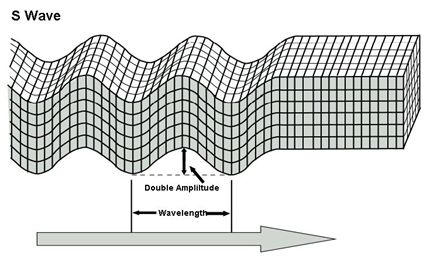
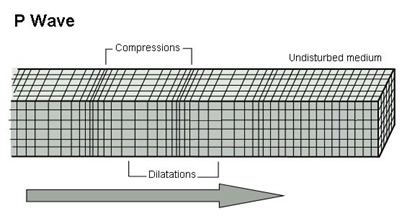
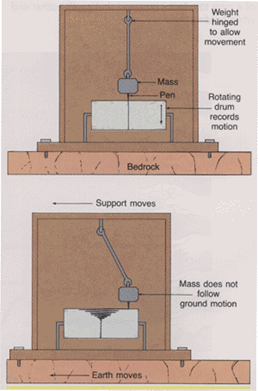
Most earthquakes move along lithospheric plates as shown in the figure.
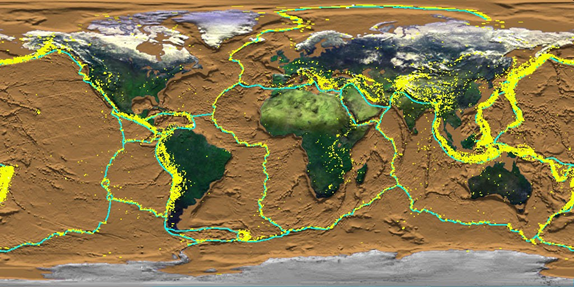
Earthquakes away from the edges of lithospheric plates often occur along faults. A fault is a fault or fault zone along which blocks have shifted.
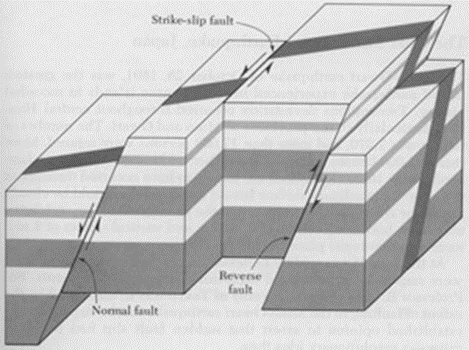
An important means of reducing the losses caused by earthquakes would, of course, be their prediction. Currently, only a long-term forecast is possible, i.e. the determination of the seismic risk of a given location, which is used by seismic engineering 20PROCHÁZKOVÁ, Dana. Seismické inženýrství na prahu třetího tisíciletí. [Praha: s.n, 2002. ISBN 80-238-8661-4.. Based on the degree of threat, it is necessary to implement appropriate measures to reduce the impact of an earthquake, i.e. according to (Procházková): technical, organizational, legal, educational.
Radionuclide methods
Radionuclide methods are based on the study of natural or artificially induced radioactivity of rocks. Radiometric methods use the natural radioactivity of rocks during prospecting and geological mapping (Švancara).
Coring methods
Coring methods are based on geophysical measurements in boreholes aimed at determining the physical properties of the rocks encountered by the borehole (Švancara).
The basic condition for the implementation of logging measurements is the existence of a borehole, which, when applying individual geophysical logging methods, makes it possible to come into direct contact with the rocks whose physical parameters should be measured and thereby obtain information about their physical properties in the natural environment. I.e. to obtain physical parameters that are very important not only for the real interpretation of surface geophysical measurements. Since the well itself already represents an artificial intervention in the natural conditions of the rock environment, and even as part of the consequences of the drilling process itself, the physical properties of the environment and the conditions in its immediate vicinity often differ from the ideal, it is necessary to realize that even if the well is on the one hand necessary a condition for the realization of logging measurements, that on the other hand, it is a factor that somewhat complicates the process of obtaining the real physical properties of the rock environment it passes through, the more so, the larger its diameter(Pospíšil 21POSPÍŠIL, Lubomil. Geofyzika a geodynamika. Modul #1, Studijní opory pro studijní programy s kombinovanou formou studia. Brno: VUT v Brně Fakulta stavební 2007.).
Coring methods – Electric method
Electrical methods can be divided into the measurement of natural and artificially induced electric fields. In the case of measuring natural electric fields, it is a matter of measuring own potentials, i.e. spontaneously arising in the borehole ( SP ) and electrode potentials ( EP ).(Pospíšil 22POSPÍŠIL, Lubomil. Geofyzika a geodynamika. Modul #1, Studijní opory pro studijní programy s kombinovanou formou studia. Brno: VUT v Brně Fakulta stavební 2007.)
Method of eigenpotentials – ( SP ). Diffusion-adsorption processes (corresponding to diffusion-adsorption potentials), filtration processes (corresponding to filtration potentials) and oxidation-reduction processes (corresponding to oxidation-reduction potentials) are considered to be the cause of self-potentials. In these cases, during the measurement, one measuring electrode (M) is lowered into the borehole and its potential relative to the electrode (N), which is located on the surface, is indicated via the registration device. The self-potential curves obtained in the sedimentary rock environment above all make it possible(Pospíšil 23POSPÍŠIL, Lubomil. Geofyzika a geodynamika. Modul #1, Studijní opory pro studijní programy s kombinovanou formou studia. Brno: VUT v Brně Fakulta stavební 2007.):
- – transverse (reflected and frontal) waves,
- – transformed waves,
- – divide the drilling profile into predominantly sandy and predominantly clayey positions,
- – separate permeable – porous rocks in the borehole profile,
- – and calculate the groundwater resistivity ρ ω for the SP static anomaly (i.e. SSP).
The analysis is also focused on determining the specific resistance of rocks, or and the rock polarizability coefficient η (when the coefficient η is defined as the ratio of the induced polarization potentials to the potential that is measured during the passing current).
Electrode potential method – ( EP ). It is used to identify conductive minerals that occur in the borehole wall and are characterized by electron conductivity [such as sulphides (except sphalerite) and oxides (eg magnetite, graphite and anthracite). In the case when such materials are found in the electrolyte together with a metal whose own potential is sufficiently negative (such as Fe or Zn), a galvanic circuit will be formed, where the electrode is the cathode and one of the discussed sulfides is the anode. As a result, a significant potential difference can be measured between them – the so-called electrode potential(Pospíšil 24POSPÍŠIL, Lubomil. Geofyzika a geodynamika. Modul #1, Studijní opory pro studijní programy s kombinovanou formou studia. Brno: VUT v Brně Fakulta stavební 2007.).
Measurement of artificially induced electric fields:(Pospíšil 25POSPÍŠIL, Lubomil. Geofyzika a geodynamika. Modul #1, Studijní opory pro studijní programy s kombinovanou formou studia. Brno: VUT v Brně Fakulta stavební 2007.)
– current logging – the difference in the conductivity of rocks is used during the measurement, or while the resistivity of ore minerals (e.g. sulfides) is of the order of 10-4 to 10-2 Ωm, the resistivity value of common rock-forming minerals is around 103 to 103 Ωm,
– resistivity logging – the measurement essentially uses the change in the resistivity of the rocks along the borehole profile. The method is generally based on the same principle as the resistivity method in surface geophysical exploration,
– induction logging – measuring the electrical conductivity of rocks,
– micro-coring – they are aimed at determining the properties of rocks in the immediate vicinity of the borehole wall; microcoroging methods are also applied in the framework of drilling exploration in coal basin areas, especially in the analysis of the structure of coal seams,
– induced polarization method – the application of this method uses a process that occurs when we first introduce a direct current into the analyzed environment and then turn it off. Since most rocks have the ability to polarize with a passing current, and are able to maintain this polarization for a certain time, it is possible to indicate a residual electric field at some point after the current is turned off, which is referred to as the field of induced potentials.
Coring methods – Acoustic method
The application of this method makes it possible to continuously measure the propagation speed of elastic waves in the rocks encountered by the well. Basically, the same principle is used for all logging probes that are used for this purpose. Each of them contains at least one transmitter of acoustic or ultrasonic waves (with frequencies from 10 to 40 kHz), as well as at least one receiver. The energy is transmitted by a piezoelectric or magnetostrictive source in the form of pulses (approx. 10 to 30 imp/s) through the washout into the borehole wall. The receiver, which is located at a certain distance from the transmitter (and is separated from it by a sound insulator), indicates the arrival time of individual pulses. The registration panel is designed in such a way that it can continuously register the arrival time t, i.e. the propagation speed of elastic waves, as well as the relative change in the amplitude of the captured impulse, or in some cases, the design of the panel makes it possible to observe the entire wave image on the oscillograph(Pospíšil 26POSPÍŠIL, Lubomil. Geofyzika a geodynamika. Modul #1, Studijní opory pro studijní programy s kombinovanou formou studia. Brno: VUT v Brně Fakulta stavební 2007.).
Coring methods – Nuclear method
These methods are widely used mainly because they are able to provide:
- – continuous documentation on the physical properties of rocks,
- – data on the material composition of rocks and fluids that fill the pores,
- – data on the technical condition of the well and on various complications that may occur in the well during the drilling process.
The methods are based on the same theoretical foundations as the surface methods of nuclear geophysics. In general, these are methods that are focused either on the registration of natural radioactive radiation of rocks, i.e. so-called passive methods (gamma logging and spectral gamma logging), or methods that use artificial sources, i.e. so-called activation methods that use artificial sources of gamma radiation, e.g.:
- – Gamma-gamma logging (density and selective),
- – Neutron – neutron logging,
- – Neutron – gamma logging.
The basic instrument used in nuclear logging is the logging radiometer, which allows detecting gamma radiation or neutron density. Devices of this type consist of a depth probe and a surface panel. Both units are connected by a logging cable.
Metoda bývá výhodně aplikována především v rámci rudní prospekce a v oblastech s výskytem slojí hodnotného černého uhlí (Pospíšil 27POSPÍŠIL, Lubomil. Geofyzika a geodynamika. Modul #1, Studijní opory pro studijní programy s kombinovanou formou studia. Brno: VUT v Brně Fakulta stavební 2007.).
Cartridge methods – Measurement of physical properties of liquids
In addition to thermometry ( TM ), resistivity measurement ( RM ) and photometry ( FM ), this group of methods also includes methods that deal with point or continuous measurement of vertical fluid velocities in the well, continuous measurement of liquid density, and in production wells also the proportion of oil – water.
Thermometry – measurement of the temperature of the liquid that moves in the well (detection of the geothermal gradient and its changes, e.g. depending on the lithology of the rocks; control of the sealing work performed in the well).
Resistimetry – measures the electrical resistance of the fluid in the borehole; it is used to determine the resistivity of rocks, as well as to determine the resistivity of leachate filtrate. In exploratory oil wells, it is used as part of the drilling process, for example, to identify places where one of the casing strings has been broken.
Photometry – is applied both in the framework of exploratory works of a hydrogeological nature, as well as in the implementation of drilling works in the framework of exploratory activities for oil and gas. During the implementation of exploratory works of a hydrogeological nature, it enables obtaining, for example, information on the extent to which the borehole was cleaned of clay wash in the final phase of solving the hydrogeological problem (e.g. when searching for suitable water sources), or from other mud additives, as well as for the purpose of determining the vertical velocity of fluid movement in the well, whether it is artificially induced or natural fluid movement (Pospíšil 28POSPÍŠIL, Lubomil. Geofyzika a geodynamika. Modul #1, Studijní opory pro studijní programy s kombinovanou formou studia. Brno: VUT v Brně Fakulta stavební 2007.).
Coring methods – Methods for determining the technical condition of the well
The methods for determining the technical condition of a well include the mentioned physical properties of liquids (see previous paragraphs) or geometric parameters of the well: within this activity, cavernometry ( KM ), profilometry , inclinometry ( TIM ) and stratimetry ( SM ) are most often applied.
Cavernometry and profilometry are among the methods that are used to determine the actual diameter of the borehole and the shape of its section in planes perpendicular to the axis of the borehole.
Inclinometry is used to measure the deviation of the borehole from the vertical and to measure the direction of this deviation (Pospíšil 29POSPÍŠIL, Lubomil. Geofyzika a geodynamika. Modul #1, Studijní opory pro studijní programy s kombinovanou formou studia. Brno: VUT v Brně Fakulta stavební 2007.).
